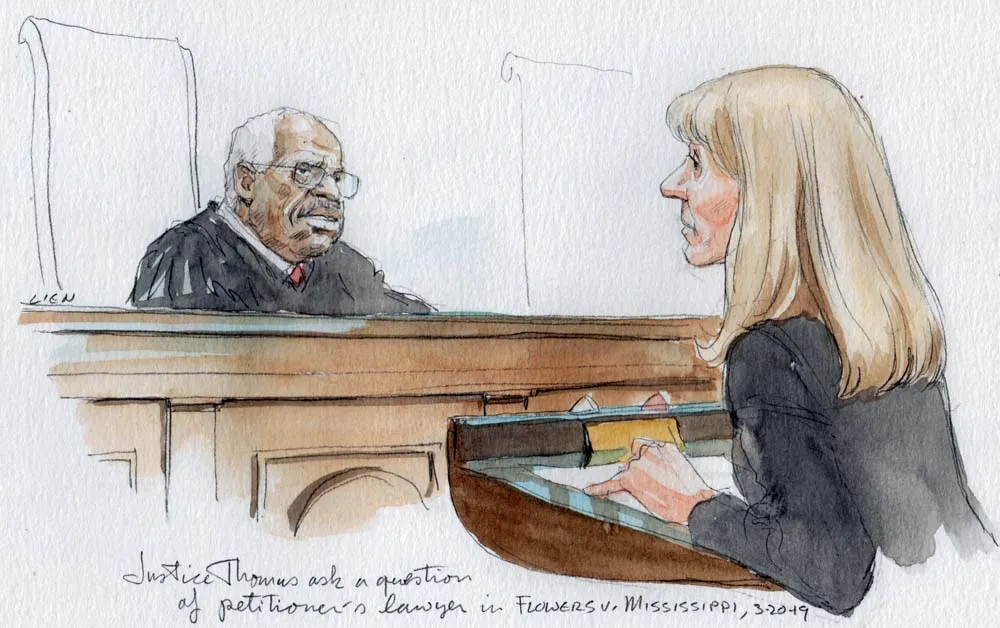Symposium
Justice Thomas has made the new oral argument format a winner
on Aug 18, 2021 at 12:37 pm

The Supreme Court has not yet announced whether it will return to normal operations when the 2021-22 term begins in October. This article is the final entry in a symposium about how the coronavirus pandemic changed the court — and which of those changes are worth keeping.
Carrie Severino is the president of the Judicial Crisis Network and was a law clerk for Justice Clarence Thomas.
When Justice Clarence Thomas joined the Supreme Court 30 years ago, the court heard twice as many cases as it does today. Oral argument also had a starkly different dynamic. An entire day of argument could go by — which, back then, could mean both morning and afternoon — without the justices asking any questions. While there were certainly aggressive questioners on the bench back then, a good number of justices took a more restrained approach with counsel.
Justice Harry Blackmun, who befriended Thomas during their overlapping service on the court, was notably unhappy with the interruptions by his more verbose colleagues and was even known to take notes tallying how many questions they were asking. Perhaps a shared sense of courtroom decorum was a factor in the warm relationship between these ideological opposites.
Since those days, Supreme Court advocates had to adjust to a hot bench in which justices would often interrupt counsel mid-sentence. In recent years prior to the pandemic, the norm became eight of the justices asking at least one question during a typical oral argument. Thomas was the exception. His reticence on the bench, which was not as noteworthy early in his tenure, became for court watchers a distinctive trait. At one point, the justice went over a decade without asking any substantive questions from the bench, and it made headlines when he broke his silence.
Thomas explained his general approach toward oral argument in 2012:
[Attorneys] have 30, 40 minutes per side for cases that are important to them and to the country. They should argue. That’s a part of the process. … I don’t like to badger people. These are not children. The court traditionally did not do that. I have been there 20 years. I see no need for all of that. Most of that is in the briefs, and there are a few questions around the edges.
On a personal note, he added, “Maybe it’s the Southerner in me. Maybe it’s the introvert in me, I don’t know. I think that when somebody’s talking, somebody ought to listen.”
Thomas has not been alone in thinking the pace of questions from justices has gotten out of hand. The court adopted a “two minute rule” for the 2019-20 term that allowed attorneys to begin arguments for two minutes without being interrupted by a justice. But two weeks did not pass before Justice Sonia Sotomayor broke the rule, and others would subsequently do the same.
Of course, Thomas is anything but a silent justice in the most substantive aspect of his work. He is a notably prolific jurist who, even if he were not to serve another day, has already earned himself a place in the pantheon of Supreme Court justices for his originalist jurisprudence. Over the past five years, he has consistently written more opinions than any of his colleagues.
After the pandemic struck and the court adopted a new format of taking turns eliciting questions from each justice by teleconference — and, significantly, making it accessible by livestream — it enabled the general public to hear Thomas as the inquisitive justice his colleagues and law clerks know behind closed doors. When the court pioneered the new format over two weeks in May 2020, Thomas asked a total of 63 questions. Seventeen of them came in one day in which the court heard cases involving wide-ranging subpoenas for President Donald Trump’s financial records, and they included several probing questions on implied legislative powers that counsel struggled to answer.
Joseph Palmore, who served as an assistant solicitor general under President Barack Obama, called Thomas’ participation the “biggest positive of the sitting,” adding, “He is a skilled and substantive questioner, and his colleagues often picked up on his questions to ask follow-ups.” Thomas remained an avid questioner through the following term, nearly always using his allotted time. He thrived in a format that was structured precisely for the orderly presentation of questions by justices.
Echoing other veteran Supreme Court advocates, Gregory Garre, who served as solicitor general under President George W. Bush, called the justice an “excellent questioner” whose questions “are clear, fair and focused on resolving the heart of the dispute before the court, not tangential issues.” He added, “Often, his questions have a practical element to them, testing the real-world ramifications of a party’s position. He’s not trying to set traps or debate academic issues.”
That was evident during oral argument in California v. Texas about how the elimination of Obamacare’s penalty implicated standing. Thomas asked among other questions,
I assume that in most places there is no penalty for [not] wearing a face mask or a mask during COVID, but there is some degree of opprobrium if one does not wear it in certain settings. What if someone violates that command? Let’s say it’s in similar terms to the mandate here but no penalty. Would they have standing to challenge the mandate to wear a mask?
After Thomas was done, Justice Stephen Breyer began, “Well, I’ll follow up on Justice Thomas’s question.”
It remains to be seen whether the court will simply revert to its traditional oral argument format in the coming term or adopt modifications similar to what we saw during the pandemic. But one thing is clear: The questioning format utilized during the pandemic-period oral arguments had the wonderful benefit of allowing for Thomas’ insightful and probative questions.


